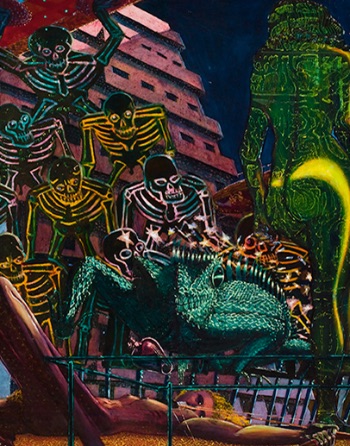More than two decades after he died of cancer at age 60, the artist, groundbreaking muralist, and beloved UC Santa Cruz professor Eduardo Carrillo is getting long-overdue recognition and national exposure, thanks to an acclaimed touring retrospective of his artwork.
“I’m just thrilled," said Betsy Andersen (Porter ‘78, art), executive director of museoeduardocarrillo.org, a comprehensive online gallery of his work. “This is a huge celebratory party for Eduardo. I have known for so long, and in such a deep way, that his work was monumental and profoundly influential.”
Andersen said this collection of artwork is doing more than just inspiring museum-goers; it is also bringing about mini-reunions of Carrillo’s artistic cohorts and collaborators, who are visiting the show together.
“Eduardo Carrillo: Testament of the Spirit” is making the rounds, traveling from one prestigious space to another, and giving museum visitors an immersive look at 60 works. The exhibition is now on display at the Triton Museum of Art in Santa Clara through January 27, 2019.
The show places a strong emphasis on Carrillo’s imagery, which has been described as “mystical, realistic, surreal, and visionary” and yet “grounded in the everyday world,” while spotlighting Carrillo’s roles as a teacher, scholar, and social activist. The exhibition also makes a strong case that Carrillo was one of Chicano Art’s founding visionaries.
Earlier this year, the exhibition was housed in the Pasadena Museum of California Art. This summer, the exhibition was on display at the Crocker Museum of Art in Sacramento, where it closed in the fall. The show received a laudatory review in the Sacramento Bee, which paid special attention to Carrillo's masterpiece, "Las Tropicanas," a magisterial 84-by-132-inch work that former San Francisco Chronicle art critic Kenneth Baker grouped among "the most remarkable paintings made in the Bay Area in the 1970s."
Starting in April 2019, the exhibition's travels will continue. It will open at American University in Washington, D.C. and be on view there until June.
Carrillo left a lasting legacy at UC Santa Cruz. He was a founding member of Oakes College and served as a fellow of both Oakes and Porter colleges. M.R.C. Greenwood, chancellor of UC Santa Cruz at the time of his death, once described him as “an extraordinarily talented artist, an imaginative, dedicated teacher, and a gentle, considerate person.” Carrillo once described himself as a “trained, disciplined observer with a humanistic viewpoint and an eye toward the spiritual and aesthetic in art.”
He taught at UC Santa Cruz for over 25 years, giving his students—including Betsy Miller Andersen—an immersive sense of collaborative art. He taught drawing, art history, ceramics, shadow puppetry, mural, fresco, and his main focus, oil and watercolor painting. He created set designs for local and national theater productions, brought art programs to children and teenagers, and supported emerging artists in the Beach Flats area. His work has been exhibited for 40 years in dozens of solo and group shows in museums and galleries throughout the U.S. and Latin America.
Carrillo’s themes explore his Mexican roots, including the pre-Columbian era and more recent historical topics. Unfortunately, some of his most striking artworks have been whitewashed over, including the monumental Birth, Death and Regeneration mural filling the Palomar Arcade walkway in downtown Santa Cruz.



